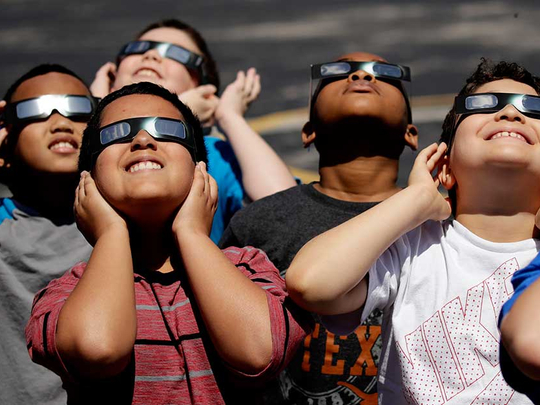
I booked my flight to Wyoming nearly a year ago — as soon as the airline would accept reservations. Ditto my hotel and rental car. Why wait, when untold numbers of other eclipse chasers were sure to be flocking to all points along the path of totality? Why risk missing a chance to stand once again under the shadow of the moon?
Today will be my ninth total solar eclipse. I saw my first one in 1991, from the deck of a ship in the Sea of Cortez. I felt I had witnessed a miracle, and although I embarked on that trip thinking one eclipse would suffice for a lifetime, the experience turned me into a repeat attender. Since then, I have planned no major vacation that didn’t involve a total solar eclipse.
In my enthusiasm for this year’s “Great American Eclipse” today, when a total solar eclipse will be visible from Oregon to South Carolina, I pressured three women who had travelled with me for one or more previous eclipses to reconnect — and all three agreed to the reunion. I also managed, through my rhapsodising, to persuade two new friends, four old friends and my family dentist to cement their own plans.
“You don’t want to miss this,” I told them, “and you don’t even need to leave the country.” All I ask now is for clear skies from coast to coast, allowing everyone bent on beholding the spectacle to be rewarded.
Eclipses over the past 25 years have carried me to Mexico, Turkey, the Galapagos, Greece, Siberia, China, Easter Island and Australia — sometimes as a reporter or guest lecturer — and still I regret the ones I missed. For reasons that seem silly now, I passed up eclipse excursions bound for Aruba, Africa and the Arctic Circle.
In answer to the “What, again?!” reactions my travel plans sometimes elicit, I try to explain the ineluctable lure that eclipses hold for me. Wherever totality occurs, the sudden midday darkness recolours the landscape and confounds the senses. The marvellous coincidence that makes the enormous sun and puny moon appear the same size in earth’s skies to create the dazzling vision that we will see does not repeat from the vantage point of any other planet.
My understanding of the astronomy in no way inures me to the emotions that an eclipse evokes. How can I watch the sun’s disc disappear and maintain any semblance of calm? I am stunned by totality’s shocking reversal of the world order.
When the sun’s disc vanishes, the glorious corona, that ordinarily invisible plasma surrounding the star, manifests itself to dominate the darkened sky. The air chills. The mind reels. Part of me wants the eerie eclipse twilight to last forever, while another part of me fears that it will. Somehow, the bizarre and beautiful effects combine to produce euphoria, and I feel about as happy as I know how to be.
Each time I’ve glimpsed the corona, its luminous streamers have taken on a different configuration. The colour of the sky likewise varied from one totality to the next, and so did the particular planets and stars that appeared when the sun’s light dimmed. No two eclipses look exactly alike. Nor do humans respond to them in the same way. The several hundred people around me in 1991 fell silent with awe. At other eclipses, I heard cries of surprise, shouts of joy, cheers, even screams.
The precise predictability of the date and duration of any given eclipse conflicts starkly with the unpredictability of the weather. “Weather permitting” gains new significance, as the weather’s permission is all. Many eclipse chasers spend the time between eclipses poring over weather data, calculating the odds along the path of totality to select the ideal observing location. I just follow the experts. I always join a group led by an experienced astronomer, because I don’t trust myself to pick a spot.
Also, I enjoy the company. I believe the eclipse experience is better shared. A few chance eclipse companions have stayed in touch over the years, and each subsequent eclipse makes it likely that our paths, like those of the sun and the moon, will cross again. At the airport in Sydney, Australia, in November 2012, I encountered six of those like-minded individuals.
I’ve never had any desire to photograph an eclipse. As an indifferent photographer, I much prefer watching the drama unfold in the moment to preserving it. After the fact, I avoid looking at other people’s pictures, because they too easily replace the image in my memory — and even the best photos are no match for the actual sight.
Only once did I view an eclipse through a camera lens. It happened on a cruise, chasing an eclipse that nowhere was visible from land: A passenger grew too seasick to capture the shot he wanted and asked for my help. Of course I said yes. There I was in the middle of the Pacific Ocean for a totality lasting only 37 seconds, voluntarily squandering several of them on shutter operation.
Mary Anna Palmer Draper showed a hundred times more selflessness during the eclipse of July 29, 1878. After trekking from New York City to the Wyoming Territory with her husband and other scientists, including Thomas Edison, she secluded herself inside a tent. There she gave up any possibility of seeing the eclipse herself to count out the seconds of totality for the rest of her party.
At my eclipse perch near Jackson Hole, today’s totality is expected to last a little more than two minutes — about 30 seconds shy of Draper’s tally. You can bet I’ll be looking skyward.
— Washington Post
Dava Sobel is the author, most recently, of The Glass Universe: How the Ladies of the Harvard Observatory Took the Measure of the Stars.









